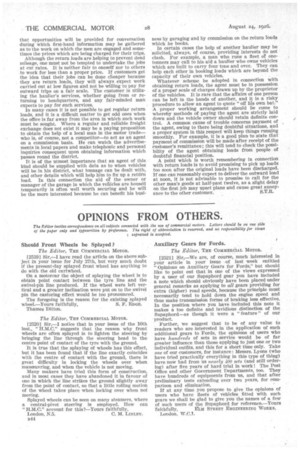OPINIONS FROM OTHERS.
Page 62

If you've noticed an error in this article please click here to report it so we can fix it.
The Editor invites correspondence on all subjects connected with the use of commercial motors. Letters should be on one side of the paper only and typewritten by preference. The right of abbreviation is reserved, and no responsibility for views
1 expressed is accepted.
Should Front Wheels be Splayed ?
The Editor, THE COMMERCIAL MoTon.
[2519] have read the article on the above subject in your issue for July 27th, but very much doubt if the present-day splayed front wheel has anything to do with the old cartwheel.
On a motorcar the object of splaying the wheel is to obtain point contact between the tyre line and the swivel-pin line produced. If the Wheel were left vertical and a greater inclination were put on to the swivel pin the castoring effect would be too pronounced.
The foregoing is the reason for the existing splayed wheel.—Yours faithfully, S. F. EDGE. Thames Ditton.
The Editor, TEE COMMERCIAL MOTOR.
[2520] Sir,—I notice that in your issue of the 10th Inst., " H.M.C." suggests that the reason why front wheels are often splayed is to lighten the steering by bringing the line through the steering head to the centre point of contact of the tyre with the ground. It is true that the splaying of wheels has this effect, but it has been found that if the line exactly coincides with the centre of contact with the ground, there is great difficulty in locking the wheels over when manceuvring, and when the vehicle is not moving. Many makers have tried this form of construction, and in most cases they have abandoned it in favour of one in which the line strikes the ground slightly away from the point of contact, so that a little rolling motion of the wheel takes place when locking over when not moving.
Splayed wheels can be seen on many steamers, where a central-pivot steering is employed. How can " H.M.C." account for this?—Yours faithfully, London, N.5. C. M. LINLEY, B44
Auxiliary Gears for Fords.
The Editor, TEE COMMERCIAL MOTOR.
[2521] Sir,—We are, of course, much interested in your article in your issue of last week entitled "Opinions on Auxiliary Gears for Fords," but should like to point out that in one of the views expressed by a user of our Supaphord gear you have included a note which should obviously have been placed under general remarks as applying to an gears providing for extra (higher) road speeds, because the principle must necessarily tend to hold down the engine speed and thus make transmission forms of braking less effective. In the position where you have included this note it makes a too definite and invidious distinction of the Supaphord—as though it were a " feature " of our product.
Further, we suggest that to be of any value to readers who are interested in the application of such additional gears to Fords, the opinions of users who have hundreds of sets in service would be of far greater influence than those applying to just one or two individual outfits, and this for a short time only. Take one of our customers, for instance : Messrs. Lyons (who have tried practically everything in this type of thing) have now had from us nearly 400 sets (and still ordering) after five years of hard trial in work I The Post Office and other Government Departments, too. They have hundreds of equipments from us, and that after preliminary tests extending over two years, for comparison and elimination.
If at any time you propose to give the opinions of users who have fleets of vehicles fitted with such gears we shall be glad to give you the names of a few of such users of the Supaphord for reference.—Yours faithfully, ELM STREET ENGINEERING WORKS. London, W.C.1.




































































































